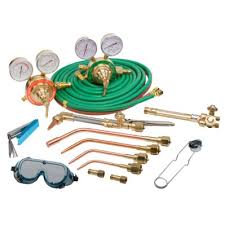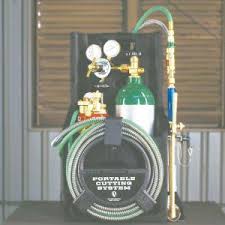backpack oxy-acetylene

Vous voulez voir cette page en français ? Enter a postal code: Ships from and sold by KapscoMoto. See more product details #24,944 in Tools & Home Improvement (See top 100) in Tools & Home Improvement > Power & Hand Tools > Power Tools > Welding Equipment > Gas Welding Equipment Would you like to give feedback on images or tell us about a lower price? Victor-Style Oxygen Acetylene Welding Cutting Kit Precision Brazing Soldering Hot Max 24010 Flashback Arrestor Set, Regulator End US Forge Welding and Cutting Oxygen Acetylene Pro Flame Pak Kit No.00820 Neiko 10921 Gas Welding and Cutting Torch Kit Victor Type with Case NEW Welding & Cutting Torch Kit Oxygen Acetylene With Portable Tote and Tanks. Our complete gas-welding accessory kit includes a 4 liter oxygen tank and 2 liter acetylene tank with regulators, along with full brass torch assembly. Use this oxyacetylene torch for welding pipes and tubes, and other metal repair work. It's also used to fabricate metal artwork.

Use it for iron or steel welding, plus brazing, braze-welding, cutting, bending and forming. Features:Welding & Cutting Torch Kit Oxygen Acetylene With Portable Tote and TanksExtremely Popular for General Maintenance Work, Metal Sculpture, Automotive Repair, Air Conditioning, Refrigeration etc. Light to Medium Duty Portable OutfitWaterproof Storage Compartment for Small ItemsRear entry regulators for better balance on the small cylindersSpecifications:Welds Up To: 3/16"Cuts Up To: 1/2"Condition: 100% Brand NewIMPORTANT PLEASE READ: The Oxygen and Acetylene cylinders are shipped empty. We strongly suggest you check with your gas supplier before buying cylinders to see what they will or will not fill or exchange. Tanks are not stamped or DOT approved.Package Includes:1x 4L Oxygen Cylinder CGA540.1x 2L Acetylene Cylinder CGA5101x Welding Goggles1x Oxygen Regulator1x Acetylene Regulator2x Welding Tips #1 and #21x Cutting Torch1x Twin Welding Hose 4.5 Meters1x Tip Cleaner1x Spanner1x Spark Lighter1x Red Carrying ToteInstructions not included

It's perfect for small jobs. I am happy with this product thank youThe Metal Vapor Torch might be the next best thing to a lightsaber: a belt tool that can generate a blade of flame that slices through a half-inch steel bar in less than a second.Energetic Materials & Products, Inc. of Round Rock, Texas designed the MVT as a tactical breaching tool for police and others who need to cut through bolts, chains, and padlocks quickly. By using reactive material technology with solid fuel and an oxidizer, the MVT is cheaper, lighter, and more compact than a traditional oxy–acetylene torch.At the heart of the MVT is a reaction between copper oxide and precisely graded particles of magnesium and aluminum; consistent particle size is crucial to ensure that the torch burns at the desired temperature. The result is a jet of flame with a temperature over 2700 C (nearly 5000 F) and a speed of over 2000 meters (more than a mile) per second. A rectangular carbon fiber nozzle shapes the jet into a flat blade for cutting.

The jet has higher energy density than a gas flame; the cutting action is produced by a combination of heat and abrasion by particles of metal oxide.The MVT is the size of a tactical flashlight and is quiet in operation. The fuel comes in small cartridges which burn for a couple of seconds; a fresh cartridge can be loaded rapidly so the operator can cut through several obstacles in quick succession, and the torch handle can be reloaded and used as many times as needed. The solid fuel is highly resistant to shock and is safe at temperatures up to 550 C (1022 F).Dennis Wilson, the CEO of EMPI, says that the torch will be priced at around $135, with the intent that it be affordable enough to be supplied to every member of a police team. Cartridges will be about $35 each. The first preproduction version of the MVT will ship later this year, and feedback from users will help shape the final production model, Wilson says.EMPI has also developed other versions of the MVT. For instance, the design can be scaled up, and Wilson has tested larger versions capable of cutting through inch-thick steel.

The MVT could be equipped with fuel cartridges that incorporate abrasive additives for cutting through fiberglass. An alternative round nozzle could punch holes rather than cutting straight lines.The MVT—which is a spinoff from work done by the U.S. Air Force—would be useful for first responders who need to cut through rebar to rescue accident victims. It works as well underwater as it does in air, making it suitable for divers, and it can be triggered remotely, or used by a robot, to swiftly disarm IEDs without setting them off.Criminals could also easily misuse it—which is why Wilson says the MVT will be supplied to approved customers only. November 4, 1916: Asbury Park, New Jersey: Secret service agents assigned to protect President Woodrow Wilson assisted in a spectacular rescue of four women trapped by a fire in the Hotel Summerfield. The women, one of whom was the wife of the president’s stenographer, were trapped on the third floor and in danger of being suffocated by the thick smoke that filled the three-story wood-frame building.

As the fire alarm sounded at 12:10 p.m., two of the secret service agents, Edward Starling and John Slye, were among the first to reach the hotel. Fifty people in the dining room exited the building quickly, as the two agents and several firefighters entered the smoke-filled building and made their way to the third floor. There they found the women trying vainly to find a way out. Other firefighters had thrown ladders to the windows and the women were carried safely to the street. The fire in the basement was then extinguished. November 11, 1916: Altoona, Pennsylvania: In the morning hours, Mrs. A.M. Wasson and her sons, Alton and Robert, were busy milking cows in their barn when a thunderstorm rolled in. A bolt of lightning struck the barn, igniting a fire. A dozen gallons of milk, the result of the day’s milking, were used to extinguish the flames-a bit more expensive than water but just as effective. The barn and all the stock were saved. November 19, 1916: Roscoe, New York: A fire broke out at 2:00 a.m. in a bowling alley and billiard rooms of B.A. Furher.

The entire interior was ablaze and spreading to other buildings as the alarm was raised. The fire quickly took hold of a meat market, a hardware store, and a garage as firefighters arrived. A woman was injured after jumping from a second-floor window to escape the heat and smoke. Because of low-pressure problems, help was sent from Liberty and Livingston Manor. At the height of the fire, thieves took advantage of the confusion and stole valuable property. The march of the fire continued, igniting a jewelry store, hotel, pharmacy, department store, theater, barber shop, storehouse, barn, and house. In all, 16 buildings were destroyed. November 19, 1916: San Francisco, California: Responding firefighters were faced with a spectacular fire that illuminated the sky above Telegraph Hill. The fire started inside the Roma Macaroni factory near the top of the hill. The firefighters battled the fire for more than an hour and were able to rescue an unconscious factory watchperson. As the flames spread to adjoining buildings, personnel were also able, with some difficulty, to rescue a woman and child trapped in a neighboring structure.

November 21, 1916: Baltimore, Maryland: Preparations for the afternoon races were underway at the Bowie track when a fire started in a racetrack stable. Within five minutes, the frame structure was fully engulfed in flames. Jockeys and hostlers risked their lives by entering the blazing structure and were able to rescue 88 horses, some with their manes and tails singed. Sadly, eight horses perished in the fire. One horse, Yellowstone, valued at $10,000, was one of the season’s best two-year-olds and had already won five straight races. One popular horse, Father Riley, was removed to safety but broke away and dashed back into the flames. November 22, 1916: Bronxville, New York: It was just before noon when neighbors notified Mrs. Colt that there were flames on the roof of her Maple Street home. Skeptical at first, she had just been in the attic and smelled no smoke, but the alarm was transmitted. The only horse-drawn fire apparatus originally responding, North End Hose Company, narrowly avoided a deadly collision as they headed to the scene.

As the rig began descending a steep hill with a difficult turn at the bottom, a trolley car began ascending. To avoid striking the trolley, the fire apparatus swerved hard and the brakes were applied. One of the horses slipped, ending up between two trees with its horse collar damaged. The company could no longer respond. Back on Maple Street, the fire produced a thick smoke condition on the second floor, hampering extinguishment. All the family belongings on the first floor were removed to safety. Chief Wallace arrived and sent in a general alarm. He then directed the hand-pumped hose streams, which had effective results. The fire was contained to one large section of the roof. November 25, 1916: New York, New York: An assistant building engineer working in a loft building on the southwest corner of Lafayette and Fourth Street heard screams and cries of pain as he returned to the building after his meal. Inside, he found a young woman with her legs wedged between the elevator edge and a beam.

The police officer on the beat saw her predicament and called for Rescue 1 of the Fire Department of New York. Under the command of Captain Hotchkiss, the rescuers used their cutting torch and began to cut away sections of the metal elevator frame. A small fire ignited under the car’s wood flooring and was quickly smothered with an extinguisher stream. The trapped woman was tended by two doctors as the rescue work continued. After 30 minutes of delicate work, she was freed and removed to a hospital. Paul Hashagen is a 40-year veteran of the fire service. He retired from the Fire Department of New York (FDNY) after 25 years of service, with 20 of those years in Rescue Company 1. Hashagen is a former chief of the Freeport (NY) Fire Department and is still a member of Truck Company 1. He has written several books and numerous stories on the history of the fire service including Fire Department City of New York: The Bravest; An Illustrated History 1865-2002; and One Hundred Years of Valor: Rescue Company 1 New York City Fire Department Rescue 1915-2015.